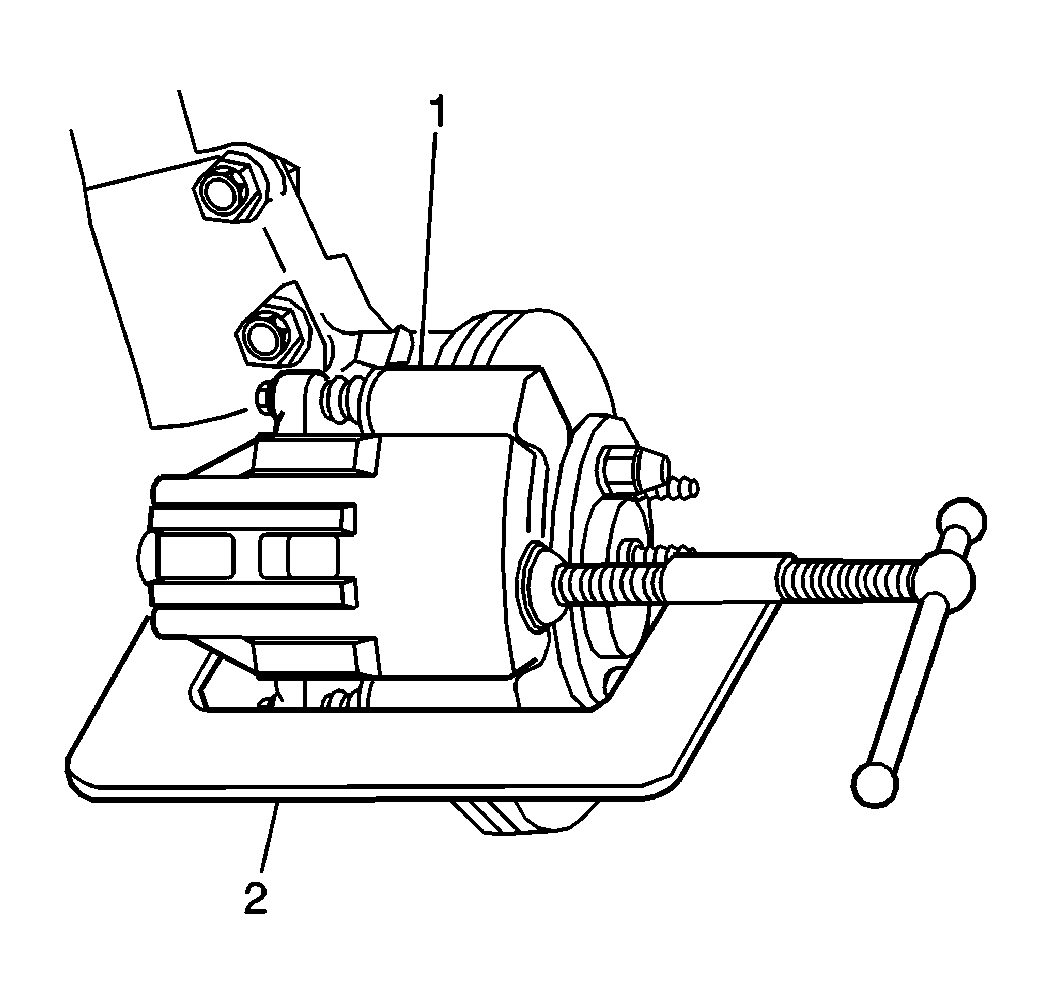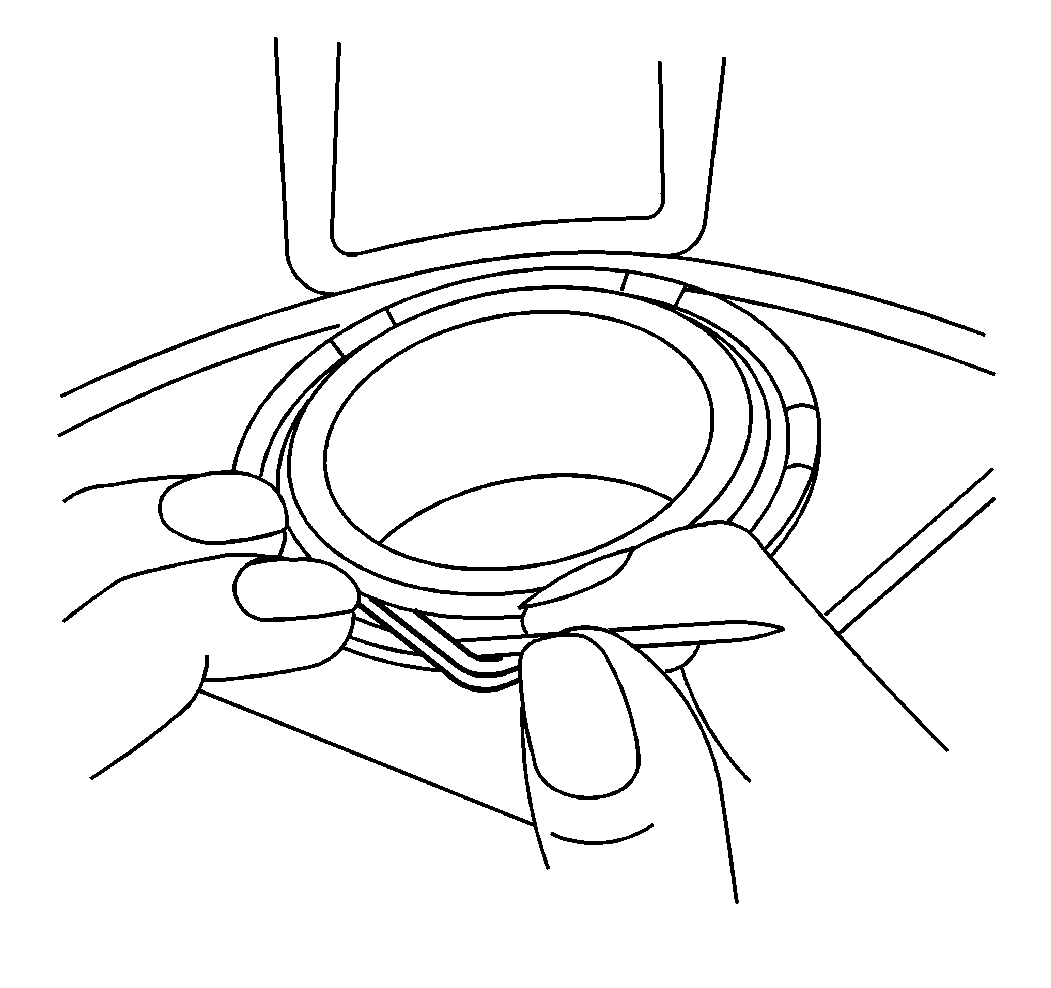Removal Procedure
Use GM replacement brake lining material (or equivalent) for all GM vehicles in order to maintain the balance between front and rear brake performance. GM replacement brake parts have been carefully selected in order to provide the proper brake balance for stopping and control over a full range of operation conditions. Installation of front or rear brake lining material not recommended for this vehicle may change the intended brake balance.
- Use a suction gun in order to remove and DISCARD approximately 33% (1/3) of the brake fluid from the master cylinder.
- Raise and support the vehicle. Refer to Lifting and Jacking the Vehicle in General Information.
- Mark the relationship of the wheel to the hub.
- Remove the tire and wheel. Refer to Wheel Removal in Tires and Wheels.
- Push the piston onto the caliper bore in order to provide clearance between the pads and the rotor. Complete the following steps:
- Remove the lower caliper bolt (1).
- Rotate the caliper (2) upward in order to access the pads.
- Remove the pads (5) from the caliper bracket (3).
- Remove the two retainers (4) from the caliper bracket.
- Inspect the following parts for cuts, tears, or deterioration. Replace any damaged parts:
- Inspect the caliper bolts for corrosion or damage. If corrosion is found, use new parts, including bushings, when installing the caliper. Do not attempt to polish away corrosion.
Install two wheel nuts in order to retain the rotor.

| 5.1. | Install a large C-clamp (2) over the top of the caliper housing (1) and against the back of the outboard pad. |
| 5.2. | Slowly tighten the C-clamp until the piston pushes into the caliper bore enough to slide the caliper off the rotor. |

| • | The bolt boots. Refer to Brake Caliper Bracket Replacement . |
| • | The piston boot. Refer to Brake Caliper Replacement . |
Installation Procedure
- Bottom the piston into the caliper bore. If installing new brake pads, use a C-clamp in order to compress the piston. Use a metal plate or a wooden block across the face of the piston in order to protect the piston and the caliper boot.
- Install the two retainers (4) to the caliper bracket (3).
- Install the pads (5) into the caliper anchor bracket.
- Lubricate the bolt (1) and the bolt boot using ONLY silicone grease.
- Swing the caliper (2) down onto the pads.
- Install the lower caliper bolt.
- Remove the wheel nuts securing the rotor to the hub.
- Install the tire and wheel. Refer to Wheel Installation in Tires and Wheels.
- Lower the vehicle.
- Fill the master cylinder to the proper level with clean brake fluid. Refer to Master Cylinder Reservoir Filling in Hydraulic Brakes.
- Apply the brake pedal three times in order to seat the pads.
- Burnish the pads and the rotors. Refer to Brake Pad and Rotor Burnishing .

Important: Before installing new brake pads, wipe outside surface of caliper boot clean. Use denatured alcohol.
Important: After bottoming the piston, lift the inner edge of the caliper boot next to the piston. Press out any trapped air. The boot must lay flat below the level of the piston face.

Important: The wear sensor is on the outside pad. Ensure that the sensor is positioned at the leading edge (upward) of the pad during forward wheel rotation.
Notice: Use care to avoid damaging pin boot when rotating caliper.
Notice: Use the correct fastener in the correct location. Replacement fasteners must be the correct part number for that application. Fasteners requiring replacement or fasteners requiring the use of thread locking compound or sealant are identified in the service procedure. Do not use paints, lubricants, or corrosion inhibitors on fasteners or fastener joint surfaces unless specified. These coatings affect fastener torque and joint clamping force and may damage the fastener. Use the correct tightening sequence and specifications when installing fasteners in order to avoid damage to parts and systems.
Tighten
Tighten the caliper bolt to 85 N·m (63 lb ft).
